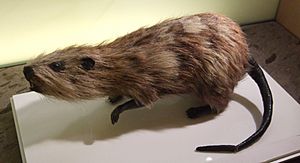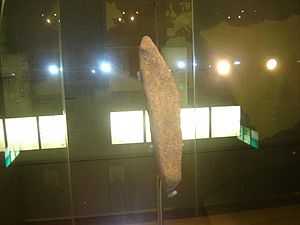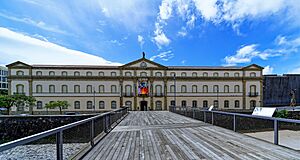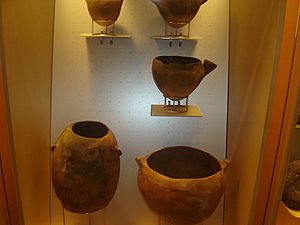Museo de la Naturaleza y Arqueología facts for kids
 |
|
| Established | 1958 |
|---|---|
| Location | Fuente Morales Street, Santa Cruz de Tenerife, Spain |
| Key holdings | Guanche culture items, mummies, Zanata Stone, amphora |
| Public transit access | Station Foundation, Tenerife Tram |
The Museum of Nature and Archeology (MUNA) is a super cool museum located in Santa Cruz de Tenerife, on the island of Tenerife in the Canary Islands, Spain. It used to be called the Museum of Nature and Man.
This museum is like a treasure chest filled with amazing finds from the ancient history of the Canary Islands. It has the best collection of items from the time before the Spanish arrived.
But it's not just about old human stuff! The museum also has huge collections of fossils, plants, insects, and animals from both land and sea. It's considered the best natural history library in the Canary Islands.
The Museum of Nature and Archeology brings together three important parts: the Archaeological Museum of Tenerife, the Canary Institute of Bioanthropology, and the Museum of Natural Sciences of Tenerife. You can find it in the center of Santa Cruz, inside an old hospital building. This building is a great example of neoclassical architecture from the Canary Islands. The part of the museum that focuses on archaeology first opened in 1958.
The museum has the biggest collection about the Guanches, who were the first people to live on the Canary Islands. It also uses modern ways to show off its mummies. This museum is famous around the world and has been part of many international meetings about archaeology. Its biggest claim to fame is its incredible collection of Guanche mummies. Many people also think it's the most important museum in the Macaronesia region.
Contents
How the Museum Started
The museum began in 1958. It used money and items from the Archaeology and Anthropology section of the Santa Cruz de Tenerife City Museum. Its first director was Luis Diego Cuscoy. He gathered a unique collection of ancient tools, pottery, and human remains from Tenerife's prehistory.
In the 1960s, the museum grew even more. It added items from African cultures and from Pre-Columbian America. Today, the museum shows off ancient archaeological items not just from Tenerife, but from all the other Canary Islands. It also has pieces from other cultures around the world.
What You Can See: Permanent Exhibitions

One of the main parts of the museum is a special area about the archaeology and burial customs of the ancient people. Here, you can see skeletons and mummified bodies of the original inhabitants of the Canary Islands, the Guanches. You'll also see objects that were buried with their kings, called Menceyes. Some of the best-preserved mummies include the famous Mummy of San Andrés and the well-known Guanche mummies of Necochea.
The museum also has a fantastic collection of ancient pottery. Plus, you can see fossils of prehistoric animals from the Canary Islands and other parts of the world. Imagine seeing the giant lizard of Tenerife (Gallotia goliath), the Tenerife Giant Rat (Canariomys bravoi), or the Tenerife giant tortoise (Geochelone burchardi). There's even a huge megalodon shark tooth and fossil remains of tiny creatures called trilobites!
Special Treasures to Discover

The museum has an amazing collection of mummies, beautiful ornaments, models of ancient villages, and pottery. These items tell the story of the Guanche culture, from its very beginnings up to the time the Spanish conquered the Canary Islands. Some of the most important pieces you can see are:
- Guanche mummies – including the famous Mummy of San Andrés.
- Zanata Stone – a rock with ancient Berber-Punic writing on it.
- Guanche ceramics and personal items.
- Mediterranean and Aegean amphoras – these are ancient jars found near the Canary Islands' shores.
- Thirteen Egyptian ceramics – these are about 5700 years old! One of them is the oldest Egyptian item in any Spanish museum.
- A tour of the museum
The Museum's Role in Big Projects
In 1992, the Museum of Nature and Man (its old name) joined a big international research project about mummies. It was called PROJECT CRONOS. This project included a worldwide exhibition of mummies. Because of this, the museum is now a global leader in how to preserve mummies.
Many foreign TV companies have filmed documentaries about mummies at the museum. For example, American JWM Productions (Discovery Channel) and Japanese NHK (Nippon Hoso Kyokai) filmed there in 2009.
The Archaeological Museum of Tenerife also took part in a huge mummy exhibition in 2010 in Granada, Spain. This exhibition showed items from many different civilizations and places. It included the 8000-year-old "Chinchorro" mummies from America. There were also sarcophagi from Egypt, mummies from the dry areas of the Andes, and "ice men" like the mummy Ötzi. Of course, it also featured the Guanche mummies from this museum.
Between 2014 and 2016, a similar exhibition called Momias, testigos del pasado (Mummies, witnesses of the past) was held. This time, the Archaeological Museum of Tenerife contributed two Guanche mummies and other ancient items. This exhibition also had mummified remains from different parts of the world and ancient cultures.
In 2015, the South Korean TV channel KBS filmed the Guanche mummies at the museum. This was for a documentary called "The Next Human". This science project aims to show how humans have evolved by looking at their DNA.
In the summer of 2015, an Italian TV show called "Misterio Adventura" also filmed a documentary at the museum.
From December 2017 to June 2018, the museum hosted an exhibition called "Athanatos. Inmortal. Muerte e inmortalidad en las poblaciones del pasado" (Athanatos. Immortal. Death and immortality in past populations). It showed examples of Egyptian, Andean, Muisca, and Asian mummies. It also featured aboriginal mummies from Tenerife and Gran Canaria, along with other items about funeral traditions. This event also included a special world congress where experts studied mummies. Many of the best mummy specialists from around the world attended. This exhibition celebrated 25 years since PROJECT CRONOS, which held the first international mummy exhibition in Tenerife in 1992.
Famous Visitors
One of the most important people to visit the museum was Stephen Hawking. He is considered one of the most famous scientists in the world. He visited in October 2014.
Why the Name Changed
In November 2018, the Museum of Nature and Man officially changed its name to the Museum of Nature and Archeology. The word "Man" was removed to make the name more welcoming and inclusive for everyone in society. However, many people still know it by its old name.
See also
 In Spanish: Museo de la Naturaleza y la Arqueología para niños
In Spanish: Museo de la Naturaleza y la Arqueología para niños
- List of museums in Spain








